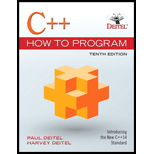
Concept explainers
For Exercises 4.13—4.16, perform each of these steps:
a) Read the problem statement.
b) Formulate the
c) Write a C++
d)Test, debug and execute the C++ program.
4.13(Gas Mileage) Drivers are concerned with the mileage obtained by their automobiles. Onedriver has kept track of several trips by recording miles driven and gallons used for each trip. Develop a C++ program that uses a while statement to input the miles driven and gallons used for each trip. The program should calculate and display the miles per gallon obtained for each trip and print the combined miles per gallon obtained for all tankfuls up to this point.
| Enter wiles driven (-1 to quit): 287 |
Enter gallons used: 13
MPG this trip: 22.076923
Total MPC: 22.076923
Enter wiles driven (-1 to quit): 200
Enter gallons used: 10
MPC this trip: 20.000000
Total MPC:21.173913
Enter the miles driven (-1 to quit): 120
Enter gallons used: 5
MPC this trip: 24.000000
Total MPC: 21.678571
Enter the miles used (-1 to quit): -1
4.14 (Credit Limit?) Develop a C++ program that will determine whether a department-store customer has exceeded the credit limit on a charge account. For each customer, the following facts are available:
- Account number (an integer)
- Balance at the beginning of the month
- Total of all items charged by this customer this month
- Total of all credits applied to this customer's account this month
- Allowed credit limit
The program should use a whilestatement to input each of these facts, calculate the new balance (= beginning balance + charges - credits) and determine whether the new balance exceeds the customer’s credit limit. For those customers whose credit limit is exceeded, the program should display the customer’s account number, credit limit, new balance and the message “Credit Limit Exceeded.”
| Enter account number (or -1 to quit): 100 Enter beginning balance: 5394.78 Enter total charges: 1000.00 Enter total credits: 500.00 Enter credit limit: 5500.00 New balance is 5894.78 Account: 100 Credit limit: 5500.00 Balance: 5894.78 Credit Limit Exceeded. |
Enter Account Number (or -1 to quit): 200
Enter beginning balance: 1000.00
Enter total charges: 123.45
Enter total credits: 321.00
Enter credit limit: 1500.00
New balance is 802.45
Enter Account Number (or -1 to quit): -1
4.15 (Sales-Commission Calculator) A large company pays its salespeople on a commission basis. The salespeople each receive $200 per week plus 9% of their gross sales for that week. For example, a salesperson who sells $5000 worth of chemicals in a week receives $200 plus 9% of $5000, or a total of $650. Develop a C++ program that uses a while statement to input each salesperson’s gross sales for last week and calculates and displays that salesperson’s earnings. Process one salesperson’s figures at a time.
| Enter sales in dollars (-1 to end): 5000.00 |
Salary is: $650.00
Enter sales in dollars (-1 to end): 6000.00
Salary is: $740.00
Enter sales in dollars (-1 to end): 7000.00
Salary is: $830.00
Enter sales in dollars (-1 to end): -1
4.16(Salary Calculator) Develop a C++ program that uses a while statement to determine the gross pay for each of several employees. The company pays “straight time” for the first 40 hours worked by each employee and pays “time-and-a-half’ for all hours worked in excess of 40 hours. You are given a list of the employees of the company, the number of hours each employee worked last week and the hourly rate of each employee. Your program should input this information for each employee and should determine and display the employee’s gross pay.
| Enter hours worked (- 1 to end): 39 Enter hourly rate of the employee ($00.00): 10.00 Salary is $390.00 |
Enter hours worked (-1 to end): 40
Enter hourly rate of the employee ($00.00): 10.00
Salary is $400.00
Enter hours worked (-1 to end): 41
Enter hourly rale of the employee ($00.00): 10.00
Salary is $415.00
Enter hours worked (-1 to end): -1
Want to see the full answer?
Check out a sample textbook solution
Chapter 4 Solutions
C++ How To Program Plus Mylab Programming With Pearson Etext -- Access Card Package (10th Edition)
- using r language Obtain a bootstrap t confidence interval estimate for the correlation statistic in Example 8.2 (law data in bootstrap).arrow_forwardusing r language Compute a jackknife estimate of the bias and the standard error of the correlation statistic in Example 8.2.arrow_forwardusing r languagearrow_forward
- using r languagearrow_forwardThe assignment here is to write an app using a database named CIT321 with a collection named students; we will provide a CSV file of the data. You need to use Vue.js to display 2 pages. You should know that this assignment is similar, all too similar in fact, to the cars4sale2 example in the lecture notes for Vue.js 2. You should study that program first. If you figure out cars4sale2, then program 6 will be extremely straightforward. It is not my intent do drop a ton of new material here in the last few days of class. The database contains 51 documents. The first rows of the CSV file look like this: sid last_name 1 Astaire first_name Humphrey CIT major hrs_attempted gpa_points 10 34 2 Bacall Katharine EET 40 128 3 Bergman Bette EET 42 97 4 Bogart Cary CIT 11 33 5 Brando James WEB 59 183 6 Cagney Marlon CIT 13 40 GPA is calculated as gpa_points divided by hrs_attempted. GPA points would have been arrived at by adding 4 points for each credit hour of A, 3 points for each credit hour of…arrow_forwardI need help to solve the following case, thank youarrow_forward
 C++ for Engineers and ScientistsComputer ScienceISBN:9781133187844Author:Bronson, Gary J.Publisher:Course Technology Ptr
C++ for Engineers and ScientistsComputer ScienceISBN:9781133187844Author:Bronson, Gary J.Publisher:Course Technology Ptr C++ Programming: From Problem Analysis to Program...Computer ScienceISBN:9781337102087Author:D. S. MalikPublisher:Cengage Learning
C++ Programming: From Problem Analysis to Program...Computer ScienceISBN:9781337102087Author:D. S. MalikPublisher:Cengage Learning EBK JAVA PROGRAMMINGComputer ScienceISBN:9781337671385Author:FARRELLPublisher:CENGAGE LEARNING - CONSIGNMENT
EBK JAVA PROGRAMMINGComputer ScienceISBN:9781337671385Author:FARRELLPublisher:CENGAGE LEARNING - CONSIGNMENT- Programming Logic & Design ComprehensiveComputer ScienceISBN:9781337669405Author:FARRELLPublisher:Cengage



